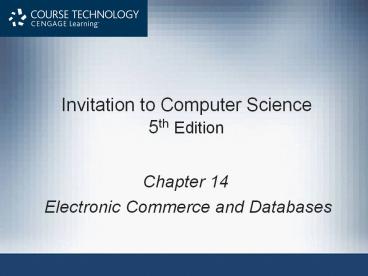Invitation to Computer Science 5th Edition - PowerPoint PPT Presentation
1 / 28
Title:
Invitation to Computer Science 5th Edition
Description:
Invitation to Computer Science 5th Edition Chapter 14 Electronic Commerce and Databases * Invitation to Computer Science, 5th Edition * Objectives In this chapter ... – PowerPoint PPT presentation
Number of Views:201
Avg rating:3.0/5.0
Title: Invitation to Computer Science 5th Edition
1
Invitation to Computer Science 5th Edition
- Chapter 14
- Electronic Commerce and Databases
2
Objectives
- In this chapter, you will learn about
- E-commerce
- Databases
3
Introduction
- E-commerce world
- Financial transactions are conducted by
electronic means - E-business
- Orders are processed, credit is verified,
transactions are completed, debits are issued,
shipping is alerted, and inventory is reduced,
all electronically
3
4
E-Commerce
- Do you want to
- Broaden your customer base?
- Recapture customers you are losing to competitors
with online stores? - Better serve your existing customer base?
- Better integrate departments/functions within
your existing business?
4
5
The Vision Thing
- Risks involved with moving into e-commerce
- Will you just move your in-store customers online
and achieve no overall gain? - When you expose yourself to online competition,
will you have something unique to offer? - Does your existing customer base need or want
anything that you dont or cant provide in your
traditional business environment? - Are the employees in your Shipping and Accounting
departments in agreement with this idea?
6
The Vision Thing (continued)
- Costs involved
- Do you have all the necessary hardware
(computers), software, and infrastructure
(network connectivity) to host a business Web
site? - Do you have the personnel and skills you need to
build and maintain a Web site? - Do you know the potential costs of diverting
resources away from your existing traditional
business?
7
Decisions, Decisions
- First major decision
- Choose between in-house development and
outsourcing - Are you going to use your existing staff to
develop this e-business - Will you lease space on someone elses commercial
Web server
8
Anatomy of a Transaction
- Goals
- Draw potential customers to your site
- Keep them there
- Set up optimum conditions for them to complete a
purchase
9
Figure 14.1 A Typical Online Transaction in Nine
Steps
10
Step 1 Getting There
- How does your potential customer learn your URL?
- Conventional advertising
- Obvious domain name
- Search engine
- Portal
11
Step 2 Do I Know You?
- Cookie
- Small text file that Web server sends to users
browser that gets stored on the users hard drive - Stateless
- No information about the exchange is permanently
retained by the server
12
Step 3 Committing to an Online Purchase
- Encryption
- Encodes data to be transmitted into a scrambled
form - Authentication
- Process of verifying the identity of the receiver
of the data - Spoofing
- Practice of impersonating a legitimate site for
the purposes of stealing money or stealing
identity
13
Steps 4 and 5 Payment Processing
Figure 14.2 Secure Site Assurance
14
Steps 69 Order Fulfillment
- Step 6
- Once customers credit is approved, order entry
system must alert inventory system - Step 7
- Contact shipping system
- Step 8
- Shipping system works with the shipping company
- Step 9
- Pick up and deliver the purchase to the customer
15
Designing Your Web Site
- Taxonomy
- How information is classified and organized so
customers can easily find what they want - Site map or a navigation bar
- Can provide a high-level overview of your site
architecture - CRM (customer relationship management) strategy
- Improve customer satisfaction
- Build customer relationships
- Bring people back to your Web site time and time
again
16
Behind the Scenes
- Middleware
- Software that allows separate, existing programs
to communicate and work together seamlessly - Disaster recovery strategy
- What are your plans for backing up critical data?
- What is your plan to keep your online business
open even when your server fails? - What will you do if a hacker breaks into your Web
site and steals customer information?
17
Databases
- Bit
- Most basic unit of data
- Combined into groups of eight called bytes
- Fields
- Group of bytes
- Record
- Collection of related fields
18
Databases (continued)
- Data file
- Stores related records
- Database
- Made up of related files
19
Figure 14.3 Data Organization Hierarchy
20
Figure 14.4 Records and Fields in a Single File
21
Figure 14.5 One Record in the Rugs-For-You
Employees File
22
Database Management Systems
- Manage the files in a database
- Entity
- Fundamental distinguishable component
- Attribute
- Category of information
- Primary key
- Attribute or combination of attributes that
uniquely identifies a tuple
23
Figure 14.6 Employees Table for Rugs-For-You
24
Database Management Systems (continued)
- Query languages
- Enable user or another application program to
query the database, in order to retrieve
information - Composite primary key
- Needed to identify a tuple uniquely
- Foreign key
- Key from another table that refers to a specific
key, usually the primary key
25
Figure 14.7 Insurance Policies Table for
Rugs-For-You
26
Figure 14.8 Three Entities in the Rugs-For-You
Database
27
Other Considerations
- Performance issues
- Affect the users satisfaction with a database
management system - To significantly reduce access time
- Create additional records to be stored along with
the file - Distributed databases
- Allow the physical data to reside at separate and
independent locations that are electronically
networked together
28
Summary
- E-business
- Every part of a financial transaction is handled
electronically - Opening an online store
- Requires a significant amount of planning
- Database
- Allows data items to be stored, extracted,
sorted, and manipulated - Relational database model
- Conceptual model of a file as a two-dimensional
table































